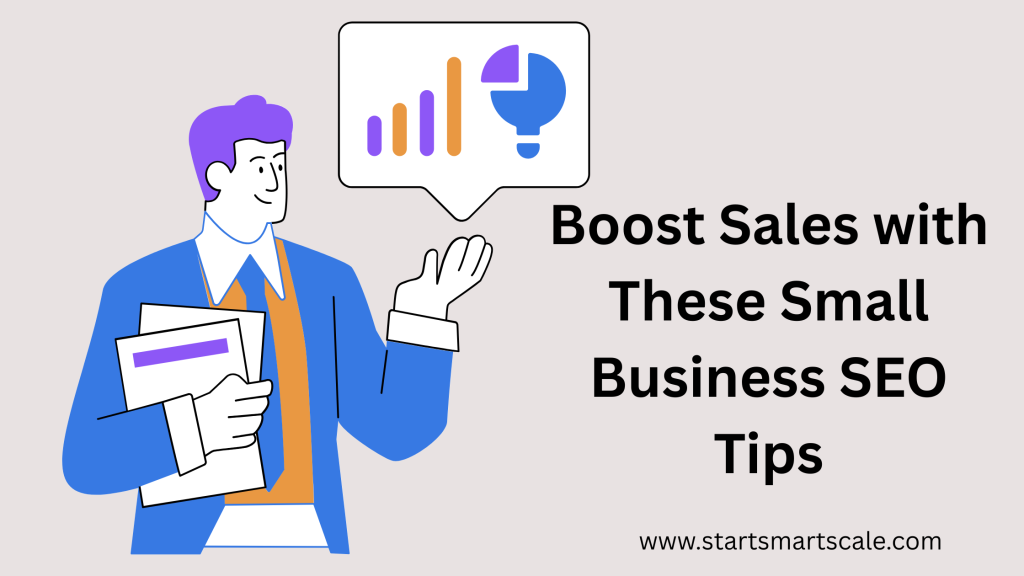Imagine hiring a sales person who works 24/7, never complains, and brings you leads while you sleep. That’s exactly what good SEO does for your small business. It’s not magic. It’s a set of strategies anyone can learn and today, you’re going to get them.

Introduction – From struggling to Thriving
When Sarah opened a small coffee shop on a quiet street in Portland. She imagined bustling mornings filled with customers, the smell of fresh espresso and the sound of friendly chatter. But reality hit hard. Days went by with only a few visitors, mostly friends and family. Despite having great coffee and a cozy atmosphere, her shop remained invisible to the very people who were searching for a cafe just like hers.
One evening, frustrated, Sarah searched “best coffee near me” on her phone. Her shop didn’t appear anywhere on Google. In fact, she had to scroll through multiple pages just to find it. That’s when she realized, her problem wasn’t the product. It was that people simply couldn’t find her.
Determine to change things, Sarah began learning the basics of SEO. She optimized her Google Business Profile, added location-based keywords to her website, and started posting blog articles with coffee tips. Within weeks, her shop started showing up in local search results. Within months, she had new customers walking in daily, saying, “I found you on Google!”
If Sarah could go from struggling to thriving with just a few SEO changes, so can you.
The right small business SEO tips can turn your business from invisible to in-demand. In this guide, we’ll walk through strategies that help small business owners boost sales, attract customers, and build long-term success.
Why SEO Matters for Small Businesses?
Search Engine Optimization (SEO) may sound technical, but it’s simple at its core. It’s the process of making your website easier to find when people search for products or services online. In other words, SEO helps connect your business to the customers who are already looking for what you sell.
Think about that, when someone wants a product, they don’t open a phonebook anymore. They go straight on Google whether it’s “best pizza near me” or affordable web development services. Search engine act like the bridge between customer questions and business solutions. If your business doesn’t appear in those search results, you’re missing out on valuable opportunity every single day.
A question may raise in your mind, why not just use paid ads? Paid ads can work, but they cost money every time someone clicks. Once you stop paying, your visibility disappears. SEO works differently. It focuses on building long-term visibility through organic search results. That means people can find your business even when you’re not spending money on ads.
Understanding Your Audience before Applying Small Business SEO
Before diving into keywords, backlinks, or technical strategies, you need to answer one simple question, who are you talking to?
Knowing your audience is the foundation of every successful SEO strategy. If you don’t understand what your customers want, you risk creating content that no one is searching for. Further, there is another possibility, you might attract the wrong people, people who land to your website but never buy.
So, how do you get to know your audience? Start with tools that reveal their behavior.
- Google Analytics shows where your visitors come from, what pages they read, and how long they stay.
- Survey and Feedback Forms gives you direct answers from real customers.
- Social Media Insights highlight what topic spark the most engagement.
Once you have this data, match your content to customer needs. For example, if you discover that most visitors search for “how to choose affordable web developer” write a blog post that answer the exact question. When your content reflects what people are already looking for, Google rewards you with better ranking.
Here, we will share a story with you for better understanding. Sarah, the coffee shop owner, once believed that her customers were only interested in “artisanal coffee blends”. But when she checked search data, she noticed people in her area were typing “bets coffee near me” into Google. By updating her website with that phrase and optimizing her Google Business Profile, she started showing up for local searches. That single move help her to understand what her audience was really asking for.
Setting the Foundation of On-Page SEO Basics
Think of your website as your storefront. If the shelves are messy, the signs unclear, and the doors hard to open, customers won’t stay long. On-page SEO is about fixing all of that so search engine and people can easily understand what your site offer.
The following points needs attention from you.
1. Title Tags, Meta Description, and Headers
Title Tags
These are clickable headlines that show up in search results. Keep them under 60 characters, clear, and keyword-focused.
Meta Descriptions
It is a short summary of your page (about 150 to 160) characters). Use it to explain why some should click.
Headers
These are H1, H2, H3… H6, that organize your content. Search engines use them to understand structure, and readers use them to build an engaging story.
2. Mobile Responsive and Fast Load Speed
Most People brows on their phones. If your site is slow or doesn’t display well on small screens, they’ll leave within seconds. Google also ranked mobile friendly websites.
- Use a responsive design that adapts to any device.
- Compress images so page load faster.
- Test your speed with tools like Google Page Speed Insights.
3. Internal Linking for Better Navigation
Think of internal links as signposts in your store. They guide visitors to other useful areas. Linking between your blog posts, product pages, and service descriptions helps users explore more.
On-page SEO basics may seems small, but together they build a strong foundation. With optimized titles, faster speed, mobile-ready design, and smart linking, your site becomes easier to find, easier to use, and far more likely to convert visitors into customers.
Further, if you want to learn 10 proven strategies to grow your small business in 2025, then cread this blog.
Keyword Research – The Heart of SEO
If SEO is the engine that drives your online presence, then keyword research is the fuel that makes it run. Without the right keywords, your website may look great but remain invisible to the people searching for your products or services.
1. Long-Tail Keywords vs Short-Tail Keywords
Long-Tail Keywords
These are more specific, such as “best coffee shop in Portland” or “affordable emergency plumber near me”. They attract fewer searches individually, but they bring in highly targeted customers who are ready to buy.
Short-Tail Keywords
These are broad terms like “coffee shop” or “plumber”. They have high search volume but also high competition. Ranking for these can be tough for small businesses.
2. Free and Paid Keyword Tools
The good news is, you don’t have to guess which keyword to use. There are tools that show you search volume, competition, and even suggest related terms.
Free Tools
Google Keyword Planner, Google Trends, Answer the Public, and Ubersuggest.
Paid Tools
SEMrush, Ahref, Moz, and KWFinder. These provide deeper insights, including competitor analysis and keywords difficulty score.
Competitor Keyword Research
Why start from scratch when you can learn from others? Competitor research helps you see which keywords similar businesses are ranking for.
- Enter competitor websites into a tool.
- Look at the keywords driving their traffic.
- Identify gaps, terms they missed that you could target.
Conclusion – Your SEO Success Story Starts Now
We’ve covered a lot of ground. From understanding your audience to mastering keyword research, optimizing on-page elements and tracking results, every step towards one goal. The beauty of SEO is that you don’t have to do everything at once. Start small. Update a few title tags. Write one helpful blog post. Claim your Google Business Profile. Each small step adds up, and consistency is what turns effort into real results.
Remember Sarah, the coffee shop owner? She didn’t become a local favorite overnight. She started by learning what her customers were searching for, updated her website, and posted simple but helpful content. Time goes, her cafe went from being nearly invisible online to welcoming new faces every day. Now, she has loyal customers who not only visit regularly but also recommend her shop to friends.






